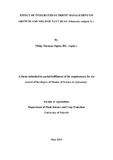| dc.description.abstract | Low soil fertility and pests are the major constraints to Navy bean (Phaseolus vulgaris L. ) production in Kenya. A study consisting of two experiments was therefore conducted in Mwea and Kabete during the 2009 short rains and 2010. The overall objective of the study was to develop integrated nutrient management options for improving productivity of canning Navy bean. The specific objectives were: (i) to determine the effect of varying combinations of organic and inorganic fertilizers on the growth and yield of canning Navy bean; (ii) to determine the interactive effects of fertilizer application and pesticide sprays on the growth and yield of canning Navy bean; and (iii) to determine the cost-effectiveness of the various fertilizer and chemical spray options in the production of canning navy bean. In the first experiment, the treatments comprised: a control with no fertilizer application, NPK (17:17:17) fertilizer at rates of 50 kg/ha, 100 kg/ha and 200 kg/ha, chicken and cattle manure each at 4 t/ha and 8 t/ha, and combinations of the three rates of fertilizer with the two rates of chicken and cattle manure respectively. The treatments were laid out in a randomized complete block design with three replications. In the second experiment, the treatments comprised fertilizer applications and pesticide sprays. The fertilizer treatments were full dose farmyard manure (8 t/ha), half dose farmyard manure (4 t/ha) plus half dose NPK (100 kg/ha), full dose NPK (200 kg/ha), Rhizobium inoculation, and a control (no fertilizer), while the pesticide treatments were fungicide spray (OrtivaR), insecticide spray (ActaraR), fungicide spray (OrtivaR) plus insecticide spray (ActaraR) and a control (no spray). The experimental design was a randomized complete block design laid out in a split plot arrangement with three replications. In both experiments Mexican 142 variety was used.
The data collected in the two experiments included: plant count, shoot biomass, root biomass, nodule number, number of pods, grain yield and 100 seed weight. Data generated were
subjected to analysis of variance (ANOVA) and treatment means compared using Genstat statistical programme. A partial economic analysis was done for the various fertilizer and chemical spray options in the production.
In the first experiment, combinations of 100 kg/ha NPK and above with chicken manure and farm yard manure each at the rate of 4 or 8 t/ha generally had significantly higher nodule number, root biomass, shoot biomass and grain yield than the untreated control and other treatments. Each of these fertilizer combinations as well as application of 200 kg/ha NPK had cost-to-benefit ratio of about 1:2. In the second experiment, all the pesticide spray treatments had significantly higher grain yield in plots supplied with 4 t/ha farm yard manure plus 100 kg/ha NPK than in unsprayed plots. Combined fungicide and insecticide sprays had higher grain yield than insecticide or fungicide alone treatment. In the Rhizobium treated plots only a combination of fungicide and insecticide significantly increased grain yield relative to the unsprayed control. Fertilizer application increased the number of nodules but pesticide application had no effect. Fertilizer application increased grain yield significantly relative to the non-fertilizer control in pesticide sprayed plots, but had no effect in unsprayed plots. Applications of 200 kg/ha NPK and half dose farmyard manure (4 t/ha) plus half dose NPK (100 Kg/ha) in combination with insecticide or insecticide/fungicide sprays were the most cost-effective treatment regimes with cost-benefit ratio of about 1:2. In conclusion, pesticide sprays, Rhizobium inoculation, application of 200 kg/ha NPK and combined moderate doses of organic and inorganic fertilizers have the potential to improve Navy bean productivity in central Kenya. | en |

